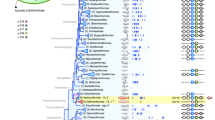Abstract
IN most vertebrate and higher invertebrate animals cellular functions are critically dependent on the relative stability of the chemical composition of the body fluids, a requirement epitomised by Claude Bernard's dictum: “la fixité du milieu intérieur c'est la condition de la vie libre”1. In higher vertebrates2,3, and in insects4, but not apparently other invertebrates5,6, the ionic homeostasis of the neuronal environment is augmented by extremely effective blood–brain barrier systems. The nerve cells of euryhaline osmoconformers, however, are exposed to considerable fluctuation in the osmotic and ionic concentrations of the body fluids7. As an example we studied the serpulid worm, Mercierella enigmatica (Fauvel), which occurs in waters in which the salinities vary from 1 to 55‰ (refs 8–10) and which can withstand relatively rapid variations in the osmotic concentration of the blood of between 43 and 1,620 mOsm (ref. 11). We report here that in spite of such extreme variations in osmotic and ionic concentration, the axons of Mercierella function using ionic mechanisms which seem essentially similar to those of other marine invertebrates, such as the giant axons of the squid12 or the polychaete, Myxicola infundibulum13. The resting potential approximates to an ideal potassium electrode (with 58.8 mV alteration for decade change in [K+]o), the action potentials are sodium-mediated (exhibiting a 55.8 mV alteration for decade change in [Na+]o) and are blocked by externally applied tetrodotoxin at about 10−7 M.
Similar content being viewed by others
References
Bernard, C. in Les Phénomènes de la Vie (Baillière, Paris, 1878).
Davson, H. in Physiology of Cerebro-spinal Fluid (Churchill, London, 1967).
Rapoport, S. I. Blood–brain Barrier in Physiology and Medicine (Raven, New York, 1976).
Treherne, J. E. in Insect Neurobiology (edit. by Treherne, J. E.), 187–244 (North-Holland, Amsterdam, 1974).
Treherne, J. E. & Moreton, R. B. Int. Rev. Cytol. 28, 45–88 (1970).
Abbott, N. J. & Treherne, J. E. in Transport of Ions and Water (edit. by Gupta, B. L., Moreton, R. B. & Wall, B. J.) (Academic, New York, in the press).
Potts, W. T. & Parry, G. in Osmotic and Ionic Regulation in Animals (Pergamon, New York, 1963).
Seurat, L. C., C.r. hebd. Séanc. Acad. Sci., Paris 185, 495–550 (1927).
Heldt, J., Stat. oceonogr. Salammbo, Notes 30, 1–4 (1944).
Tebble, N. J. Inst. municip. Engrs. 80, 259–263 (1953).
Skaer, H. le B. J. exp. Biol. 60, 321–330 (1974).
Hodgkin, A. L. in The Conduction of the Nervous Impulse (Liverpool University Press, 1964).
Goldman, L. J. cell Physiol. 71, 33–42 (1968).
Skaer, H. le B. J. exp. Biol. 60, 331–338 (1974).
Treherne, J. E. & Pichon, Y. Adv. Insect Physiol. 9, 257–313 (1972).
Abbott, N. J., Moreton, R. B. & Pichon, Y. J. exp. Biol. 63, 85–115 (1975).
Author information
Authors and Affiliations
Rights and permissions
About this article
Cite this article
TREHERNE, J., CARLSON, A. & SKAER, H. Facultative blood–brain barrier and neuronal adaptation to osmotic stress in a marine osmoconformer. Nature 265, 550–553 (1977). https://doi.org/10.1038/265550a0
Received:
Accepted:
Issue Date:
DOI: https://doi.org/10.1038/265550a0
- Springer Nature Limited





